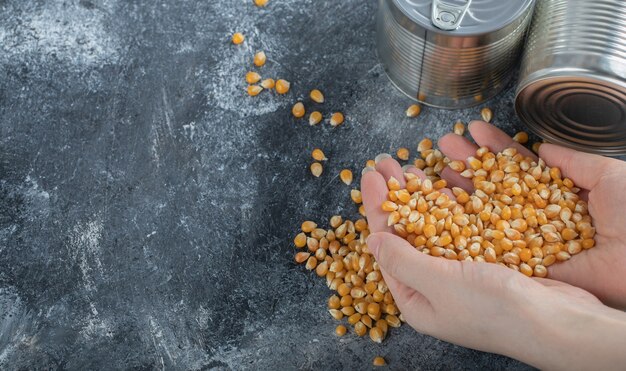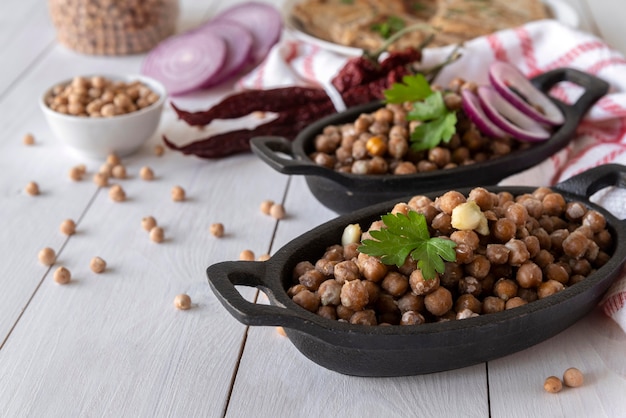pinto beans – those little speckled wonders – have a special place in my heart (and my pantry!). They're a culinary workhorse, incredibly versatile, and so darn good for you. But let's face it, the whole soaking, simmering thing can seem a bit daunting. Don't worry! I'm here to break it down, share my tried-and-true tips, and turn you into a pinto bean pro. So grab your favourite mug, settle in, and let's get cooking.
(Part 1) Pinto Beans: The Basics

Before we dive into the cooking process, let's get acquainted with these little gems. Pinto beans, as you may know, are a type of legume. They pack a nutritional punch, bursting with protein, fibre, and various essential vitamins and minerals. But beyond the health benefits, they also have a unique, earthy flavour that adds depth to countless dishes.
Now, pinto beans come in two main forms:
1.1. dried pinto beans
These are the real deal, the unadulterated pinto beans in their purest form. They're the kind you find in bulk bags at the supermarket, ready for your culinary magic. You'll need to soak and simmer them, but the wait is worth it for that robust, authentic flavour that's hard to replicate. I always keep a bag of dried pinto beans on hand – they're a kitchen staple for me.
1.2. canned pinto beans
For those days when time is of the essence, canned pinto beans are a godsend. They're already cooked, saving you precious time and effort. Pop open a can, drain them, and you're ready to go! But be warned, they sometimes have a slightly metallic taste that can be a bit off-putting. I tend to use them in dishes where the flavour is masked, like chili or dips.
(Part 2) The Art of Soaking: Preparing Your Beans for Perfection

soaking pinto beans is like giving them a little pre-cooking spa treatment. It's a crucial step that helps them cook faster and more evenly. It also removes some of the compounds that can cause gas and makes them easier to digest.
There are two main soaking methods, and I'll walk you through each one:
2.1. The Overnight Soak: For Maximum Flavour and Tenderness
This is my go-to method, especially when I have time to plan ahead. It's simple, effective, and the results are truly worth it.
- Rinse: Give your beans a good rinse under cold water to remove any debris.
- Soak: Place them in a large bowl, cover them with plenty of cold water (at least two inches above the beans), and pop them into the fridge. Let them soak for at least 8 hours, or up to 24 hours.
2.2. The Quick Soak: When Time is Tight
Let's face it, sometimes life throws curveballs, and you don't have hours to soak your beans. That's where the quick soak comes in. It's a lifesaver for those impromptu meal plans.
- Rinse: Just like before, give those beans a thorough rinse.
- Boil: Transfer them to a large pot and cover them generously with cold water. Bring the water to a rolling boil over high heat. Then, reduce the heat to low and let them simmer for one hour.
- Drain: Drain the beans and proceed with the cooking instructions below.
(Part 3) The perfect pinto bean Cooking Time: Finding Your Sweet Spot

Ah, the million-dollar question: how long do you cook pinto beans? The answer, like most things in cooking, depends on a few factors.
- Type of beans: dried beans will take longer than canned beans, naturally.
- Quantity: A larger batch will need more time to cook through.
- Personal preference: Some people love their beans soft and mushy, while others prefer a bit of bite. It all comes down to your taste.
Here are some general guidelines to get you started:
3.1. Cooking Times for Dried Pinto Beans
For dried pinto beans that have been soaked overnight, you can expect a cooking time of 1 to 2 hours. If you've opted for the quick soak method, add an extra 30 to 45 minutes to the cooking time.
3.2. Cooking Times for Canned Pinto Beans
Canned beans are already cooked, so you don't need to cook them further. However, if you're using them in a dish that requires simmering, add them to the pot for the last 30 minutes of cooking.
(Part 4) cooking pinto beans: A Step-by-Step Guide to Deliciousness
Ready to take the plunge and cook your pinto beans? Let's do this!
- Drain and rinse: After soaking, drain your beans and give them another good rinse under cold water. This helps remove any excess starch and prevent stickiness.
- Pot it up: Transfer the beans to a large pot and cover them with fresh water, ensuring the water is about two inches above the beans.
- Bring it to a boil: Heat the pot over high heat, bringing the water to a rolling boil.
- Simmer and check: Once it boils, reduce the heat to low, cover the pot, and let it simmer for 1 to 2 hours (or longer if needed, depending on the factors mentioned above). Taste a bean to check for tenderness. If it's still a bit firm, continue simmering for another 15 to 20 minutes.
- Rinse again: Once the beans are cooked to your liking, drain them and rinse them again under cold water. This will help remove excess starch and prevent them from becoming sticky.
(Part 5) Pro Tips for Perfectly Cooked Pinto Beans: Elevate Your Bean Game
Now that we've covered the basics, let's explore some tricks that'll elevate your pinto bean game to a whole new level.
5.1. The Don't-Overcook Rule
The key to perfect pinto beans is to cook them until they're tender, but not mushy. Overcooked beans lose their shape and become a bit gloopy, which can be a texture disaster.
5.2. Flavour Booster: Unleash the Bean's Potential
Pinto beans are a blank canvas for flavour, so don't be shy to experiment! Here are some ideas to get you started:
- Bay leaf: Add a bay leaf or two to the pot for a touch of savoury depth. It disappears during cooking, leaving behind its subtle, earthy aroma.
- Garlic: Toss in a few cloves of garlic for a punch of flavour that'll make your beans sing.
- Onion: A diced onion adds sweetness and complexity to the beans. It's a classic combination that always works.
- Salt and pepper: Season your beans with a pinch of salt and pepper towards the end of cooking for a perfectly balanced flavour.
- Spice it up: Add other spices like cumin, chili powder, paprika, or even a touch of cayenne pepper, depending on your desired heat level. Be creative!
5.3. Storage Secrets: Keep Your Beans Fresh and Ready for Action
Cooked pinto beans can be stored in the refrigerator for up to 5 days or frozen for up to 3 months. Simply transfer them to airtight containers and store them in the freezer.
(Part 6) A World of Possibilities: Pinto bean recipes to Inspire You
Get ready to unleash your inner culinary wizard! Pinto beans are incredibly versatile and can be used in countless delicious dishes.
6.1. Hearty Chili: A Classic comfort food
Pinto beans are a staple in chili, their hearty texture and earthy flavour perfectly complementing the other chili ingredients. Try a traditional chili recipe or experiment with your own unique blend of spices.
6.2. Flavourful Burritos: A Customizable Treat
Whether you're making breakfast burritos or dinner burritos, pinto beans are a must-have. Their creamy texture and robust flavour pair beautifully with rice, cheese, salsa, and your favourite fillings.
6.3. Satisfying Salads: A Protein Boost with a Crunch
Don't underestimate the power of pinto beans in salads! They add a protein boost and a satisfying texture that complements fresh vegetables and flavorful dressings.
6.4. Delicious Dips: From Classic to Creative
Pinto beans are the base for some of the best dips around. Think black bean salsa, refried beans, and even dips with a touch of cheese and spices. They're perfect for parties and casual gatherings.
6.5. Comforting Soups: A Warm Embrace on a Chilly Day
Pinto beans are perfect for making hearty, satisfying soups. They add a creamy texture and a rich flavour that warms you from the inside out.
(Part 7) FAQs: Your Pinto Bean Questions Answered
I'm sure you still have a few burning questions about cooking pinto beans. Let's clear them up!
7.1. What happens if I don't soak my beans?
You can cook your beans without soaking them, but it will take much longer (up to 3 hours or more). They may also be a little harder to digest. Soaking is definitely recommended, but if you're in a pinch, it's not a deal-breaker.
7.2. Can I use canned beans instead of dried beans?
Absolutely! Canned beans are a great shortcut. Just be aware that they may have a slightly metallic taste, so choose your recipe accordingly.
7.3. How do I know when my beans are done?
The best way to tell is by testing the beans for tenderness. A cooked bean should be soft but not mushy. You should be able to easily mash it with a fork.
7.4. What should I do with leftover pinto beans?
Good news! Leftover pinto beans are a culinary treasure. You can store them in the refrigerator for up to 5 days or freeze them for up to 3 months. They're fantastic in salads, burritos, soups, and dips, adding flavour and texture to any dish.
7.5. Can I add salt to the beans while they're cooking?
Some people say that adding salt to the beans while they're cooking can make them tough. I personally don't find this to be a problem, but you can always wait until the end of cooking to season your beans. Experiment and see what works best for you.
(Part 8) Conclusion: Embrace the Bean, Embrace the Flavour
There you have it, my friends! That's the inside scoop on cooking pinto beans. Hopefully, this guide has demystified the process, given you the confidence to cook these versatile legumes to perfection, and sparked your culinary creativity.
Remember, the key is to cook them until they're tender but not mushy, and to have fun with your flavor combinations. Whether you're making a hearty chili, a refreshing salad, or a creamy dip, pinto beans are always a welcome addition to your meals.
So, go forth and cook up a storm! Embrace the bean, embrace the flavour, and enjoy your delicious culinary creations.
Everyone is watching

Corn on the Cob: The Ultimate Guide to Perfectly Cooked Ears
Healthy MealsAh, corn on the cob. Just the name evokes images of sunny days, barbecues, and that sweet, juicy flavour that ...

Perfect Pork Roast Oven Cooking Time: A Guide to Delicious Results
Healthy MealsThere's something truly satisfying about a perfectly roasted pork. The aroma alone is enough to make your mout...

Ham Cooking Time: How Long to Bake, Smoke, or Boil a Delicious Ham
Healthy MealsAh, ham. It's a classic, isn't it? A real crowd-pleaser, especially around holidays. And when done right, it'...

Scallops: The Ultimate Guide to Perfect Cooking
Healthy MealsAh, scallops. Those delicate, sweet, and utterly delicious morsels of the sea. They hold a special place in my...

Spaghetti Squash: The Ultimate Guide to Cooking and Serving
Healthy MealsRemember that time you saw spaghetti squash at the supermarket, looking all bumpy and strange, and thought, "W...
